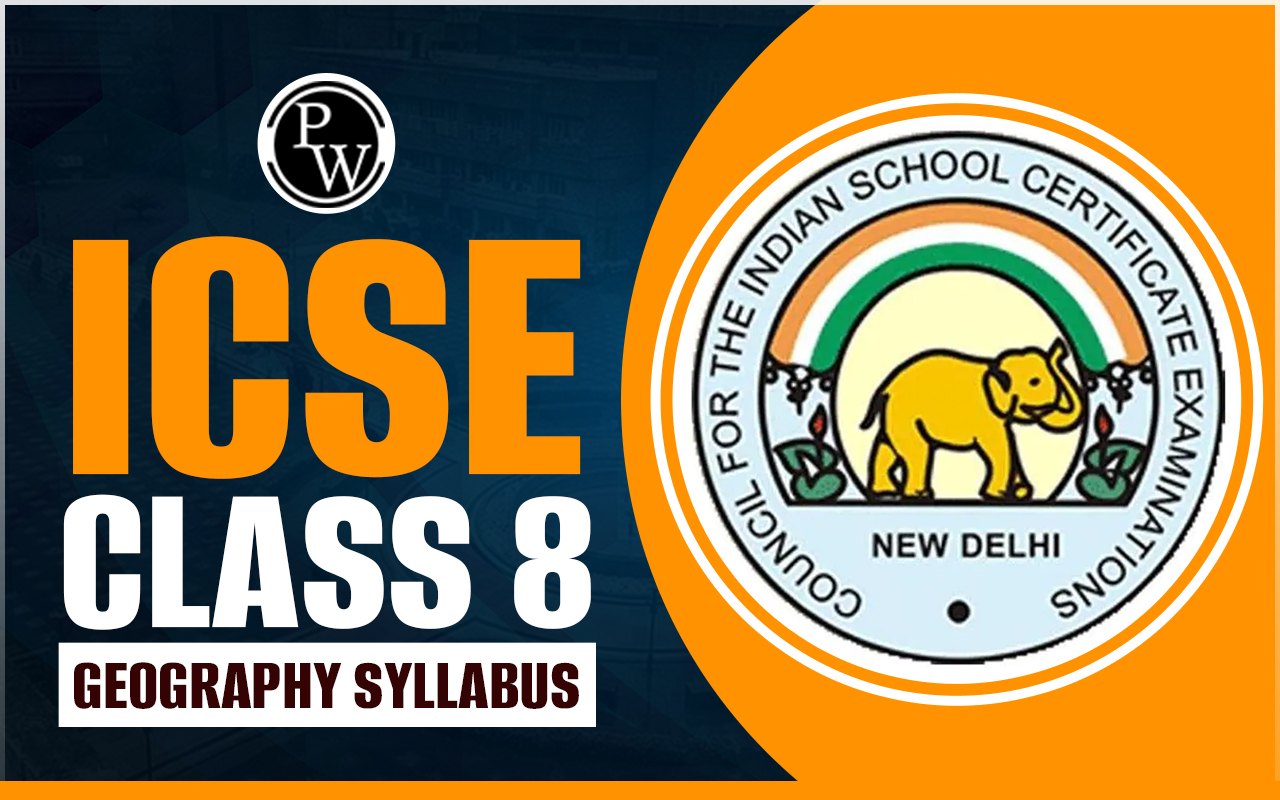
ICSE Class 8 Geography syllabus for 2025–26 covers a wide range of topics that help students understand the physical and human aspects of the Earth. It introduces learners to resources, landforms, climate, vegetation, population, and environmental issues.
The syllabus is designed to develop geographical skills like map reading, observation, and analysis of natural and man-made features. With a blend of theory and practical learning, this subject aims to build awareness about sustainable development and global interdependence, preparing students for more advanced studies in the future.
ICSE Class 8 Geography Syllabus 2025-26
ICSE Class 8 Geography syllabus includes key topics that are essential for building a strong foundation in geography. The table below lists all the units covered in the syllabus for 2025-26.
| ICSE Class 8 Geography Syllabus 2025-26 | |
| Unit No. | Topics |
| 1. | Representation of Geographical features |
| 2. | Population Dynamics |
| 3. | Migration |
| 4. | Urbanisation |
| 5. | Natural and Man-made disasters |
| 6. | Asia- The Largest Continent |
| 7. | India- Geographical Features |
| 8. | India- Human Resources |
ICSE Class 8 Geography Syllabus Exam Pattern
Understanding the exam pattern is essential to prepare effectively for the ICSE Class 8 Geography exam. The exam is usually 2 hours long and carries a total of 80 marks. It is divided into two main sections:
-
Section A (40 marks): This section includes objective-type questions such as multiple-choice questions (MCQs), fill-in-the-blanks, true/false, and other short-answer formats based on the entire syllabus.
-
Section B (40 marks): This section contains subjective questions requiring detailed answers. It is further divided into:
-
Part I (20 marks): Short-answer questions to test understanding of key concepts.
-
Part II (20 marks): Long-answer questions that assess the ability to apply geographical knowledge, analyse scenarios, solve problems, or draw maps.
Marking Scheme:
-
Each question in Section A usually carries 1 mark.
-
In Section B, marks vary:
-
Part I answers are generally awarded 2-3 marks each.
-
Part II answers can carry 5-10 marks, depending on the question's depth and complexity.
ICSE Class 8 Geography Syllabus 2025-26 in Detail
Geography can be a bit tricky and sometimes puzzling due to its diverse words. Many folks might feel it's dull, especially if they're not very clear on the concepts.|They use symbols and colours to represent different things. People learn about contours on these maps and understand them. They also learn to draw contours on regular sheets to show things like hills, valleys, and plateaus. After going through this chapter, students will find it easy to:
- Understand the shapes shown on the topographic sheets.
- Tell the difference between steep and gentle slopes, for instance.
- Identify landforms by looking at the shapes on the topographic sheets.
- Recognize various settlement patterns on topographic sheets.
- Sketch outlines on empty papers.
- Explain the various factors that impact the population of a region.
- Understand how society is impacted by too many or too few people.
- Recognize countries in the world that have too many or too few people.
- Understand a population pyramid that shows how the population is distributed by age and gender.
ICSE Class 8 History and Civics Syllabus
Unit 3. Migration The primary aim of this topic is to understand why people move from one location to another for various reasons. Kids learn about the diverse ways individuals migrate and how it influences the social and economic development of the area. Students can explore subjects related to brain drain and its effects on society within this topic. Students can do the following if they understand the subjects well:- Tell apart immigration and emigration.
- Talk about why people move.
- Look into how moving affects different places.
- Understand which parts of the world had major historical migrations.
- Know what "brain drain" is.
- Find out why there's brain drain in India.
- Understand the good and bad sides of brain drain in India.
- Understand the meaning of "urbanisation" and identify what causes it.
- Discuss the impact of urbanisation on society.
- Differentiate between smart cities and other big cities.
- Describe the local actions taken to keep metropolitan areas clean.
- Spot natural and human-made disasters.
- Understand the importance of disaster management.
- Demonstrate the necessary actions during an earthquake, flood, or fire.
- Describe where earthquakes, floods, and oil spills come from, their results, and how they affect people and the environment.
- Take preventive measures to reduce disaster impact.
ICSE Class 8 Chemistry Syllabus
Unit 6: Asia: The Largest Continent Children are already familiar with the basics of the continents. In this unit, kids learn about Asia, which is the biggest continent in the world. The children are taught about the natural features and landscapes of this continent. After finishing the chapter, students will be able to:- Locate Asian countries on a world map and a globe.
- Identify important natural features like mountains, plateaus, deserts, rivers, lakes, and islands on the map of Asia.
- Explain the impact of the extent of latitude and distinct terrain features on Asia's weather.
- Explore the connections between the climate and the plants native to the region.
- Evaluate the interdependence of climate and natural vegetation in Asia.
- Identify where India is and how big it is compared to other countries in Asia.
- Locate important land features on the map of India, like mountains, plateaus, deserts, islands, and rivers.
- Compare and see the differences in India's land, weather, and plants compared to other countries in Asia.
- Explain the importance of the monsoon and how it impacts the social and cultural life of the country.
They also explore places in India where natural resources are not being used to their maximum capacity. A learner will be able to do the following:
- Grasp and value the meaning of the term "human resource" by the end of this chapter.
- Talk about the role of education and health in shaping human resources.
- Distinguish between people with skills and those without in the human resources context.
- Identify the areas where India is lagging in growth due to a lack of unskilled labour.
- Explore the various factors contributing to the development of a region.
ICSE Class 8 Geography Syllabus Preparation Tips
Class 8 Geography forms the base for knowing about our world, from reading maps to discovering interesting land shapes and cultures.Doing well in this subject needs getting ready and having the correct method. Below are some thorough suggestions to assist you in doing great in your ICSE Class 8 Geography tests:
- Grasp the Syllabus Completely:
- Obtain the official ICSE Class 8 Geography syllabus.
- Understand the various themes and sub-themes it covers.
- Identify key concepts, learning objectives, and important maps and diagrams.
- Focus on the assigned weightage for each section during exam preparation.
- Improve Map Skills:
- Practice reading topographic maps, recognizing landforms, and dealing with contours.
- Learn to create maps, find places, and mark important features.
- Utilise tools like Google Earth online to visualise geographical concepts.
- Embrace Active Learning:
- Go beyond just reading the textbook. Explore additional resources like atlases, documentaries, and online quizzes.
- Actively participate in class discussions and ask questions if confused.
- Form study groups with friends to discuss concepts and clarify doubts.
- Create Smart Notes:
- Develop concise and organised notes based on the textbook and class lectures.
- Use diagrams, flowcharts, and mind maps to visualise relationships between concepts.
- Highlight key terms, definitions, and important geographical locations.
- Practise a Lot:
- Solve questions from previous years and sample papers to understand question formats and difficulty levels.
- Practice answering different types of questions, including objective, short, and long ones.
- Time yourself during practice to improve exam speed and accuracy.
- Extra Tips:
- Stay updated on current events related to geography, such as natural disasters, environmental issues, or political developments.
- Make learning enjoyable! Use visuals, start projects, or connect geographical concepts to your daily life.
- Stay positive and motivated throughout your preparation.
ICSE Class 8 Geography Syllabus FAQs
How many chapters are there in the ICSE Class 8 Geography syllabus?
What is the exam pattern for ICSE Class 8 Geography?
Are map drawing questions included in the ICSE Class 8 Geography exam?
How can students prepare effectively for the ICSE Class 8 Geography exam?










